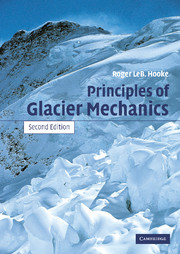Book contents
- Frontmatter
- Contents
- Preface to the first edition
- Preface to the second edition
- Physical constants relevant to ice
- Derived SI units and conversion factors
- 1 Why study glaciers?
- 2 Some basic concepts
- 3 Mass balance
- 4 Flow and fracture of a crystalline material
- 5 The velocity field in a glacier
- 6 Temperature distribution in polar ice sheets
- 7 The coupling between a glacier and its bed
- 8 Water flow in and under glaciers: geomorphic implications
- 9 Stress and deformation
- 10 Stress and velocity distribution in an idealized glacier
- 11 Numerical modeling
- 12 Applications of stress and deformation principles to classical problems
- 13 Finite strain and the origin of foliation
- 14 Response of glaciers to changes in mass balance
- Appendix: Problems
- References
- Index
14 - Response of glaciers to changes in mass balance
Published online by Cambridge University Press: 24 November 2009
- Frontmatter
- Contents
- Preface to the first edition
- Preface to the second edition
- Physical constants relevant to ice
- Derived SI units and conversion factors
- 1 Why study glaciers?
- 2 Some basic concepts
- 3 Mass balance
- 4 Flow and fracture of a crystalline material
- 5 The velocity field in a glacier
- 6 Temperature distribution in polar ice sheets
- 7 The coupling between a glacier and its bed
- 8 Water flow in and under glaciers: geomorphic implications
- 9 Stress and deformation
- 10 Stress and velocity distribution in an idealized glacier
- 11 Numerical modeling
- 12 Applications of stress and deformation principles to classical problems
- 13 Finite strain and the origin of foliation
- 14 Response of glaciers to changes in mass balance
- Appendix: Problems
- References
- Index
Summary
As we discussed in Chapter 3, climatic change may involve changes in precipitation, in temperature, in radiation balance, or most likely in all three of these variables. From the perspective of a glacier, however, the net effect is to change the amount and the spatial distribution of accumulation and melt. This leads to discrepancies between the specific net balance and the local emergence or submergence velocity, and hence to changes in glacier geometry (see pp. 90–92).
Were the climate of a region to remain constant for a long time, several decades or even centuries, the geometry of non-surging glaciers in that region would adjust so that the specific net balance was everywhere equal to the local emergence or submergence velocity, and in addition (or as a consequence) the integral of the specific net balance over the glacier, Bn = ∫bndA, would be zero. The glacier would then be said to be in a steady state, an ideal that may occasionally be approached but rarely, if ever, reached.
The principal adjustment that takes place is, of course, a change in length or size. A positive mass balance, maintained over a period of years, will result in an advance. As the glacier expands to lower elevations or more southerly latitudes, the summer balance becomes more negative until it becomes equal (in magnitude) to the winter balance, and the net balance returns to zero, and conversely.
The goal of this chapter is to study the details of the adjustment process.
- Type
- Chapter
- Information
- Principles of Glacier Mechanics , pp. 365 - 390Publisher: Cambridge University PressPrint publication year: 2005



